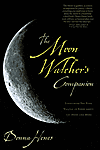
Not since the publication of Anne Kent Rush’s Moon, Moon (Random House) in 1976 has there been such a handy compendium of moon lore. Urban shaman Donna Henes, of Exotic Brooklyn, New York, who is also author of The Queen of My Self and other books and a traveling ceremonialist, opens this book with a poem from A Child’s Garden of Verses: “The moon has a face like the clock in the hall;/ She shines on thieves on the garden wall.”
And The Moon Watcher’s Companion is a full moon of scholarship. The three major sections are Faces in the Moon, Phases of the Moon, and Facts about the Moon. We learn about the man in the moon, the moon mother, and moon spirits and animals, and there is a four-page list of lunar deities: 17 moon gods (including duplicate gods with alternative names) and 88 goddesses from ancient and modern peoples clear around the world. We may be familiar with Thoth or Sin (whose name is in Mt. Sinai) or with Al-Lat (pre-Islamic Arabian), Arianrod, Chang O, and Ix Chel, but we also learn about Myesyts (Serbian god), Brizo (Greek goddess from the island of Delos), Hard Beings Woman (Hopi), Macha Alla (Central Asia), and Mana, from whom we get the word “maniac” just as “lunatic” comes from “luna.”
Henes clarifies a point too often ignored by pagans and witches. The moon does not have three phrases. It has four phases: waxing, full, waning, and dark/new. The waxing crescent moon comes from the Latin word crescere, which means “to grow.” Numerous holidays marked on lunar calendars begin when one or more people sight the first crescent of the waxing moon, which is also when the new month officially begins. In Greece, women presented full moon cakes to Artemis; this was the origin of our birthday cakes with candles. We don’t ordinarily do magic during the waning moon because we think of it as diminishing or negative energy. That’s not true, Henes says. “There is a critical, valuable place in the cycle for the waning process. Waning is less a matter of fading, than of distillation. Of ingathering. Of seasoning. The shriveled crescent of the old moon is like the intensified sweetness of a once succulent fruit that has been slowly dried in the sun” (p 43), like the wine made from sweet grapes. Thinking of the waning moon as a period of distillation could be the source of effective magic. The dark/new moon is referred to as “the inside days,” the alpha as well as the omega of creativity and life energy.
“We make the moon our personal friend [Henes writes], our confessor, our reference, our partner. We tell it our secrets and invite its light to illuminate our inner feelings. We find comfort in its predictable and orderly progress through the cycles, reminding us that everything is mutable, that everything changes and that this mood, too, shall pass” (p. 54).
Henes also discusses lunar calendars and presents scientific theories about the origin of the moon, the moon’s surface, and moon rocks. There are five kinds of months: synodic or lunar, sidereal, anomalistic, nodical or draconic, tropical. It depends on where you start measuring. Henes concludes with an encyclopedia of lunar terminology (“lucifugous” means turning away from the light) and the names of the moon in 32 languages.
~review by Barbara Ardinger, Ph.D.
Author: Donna Henes
Marlowe & Company, 2004
